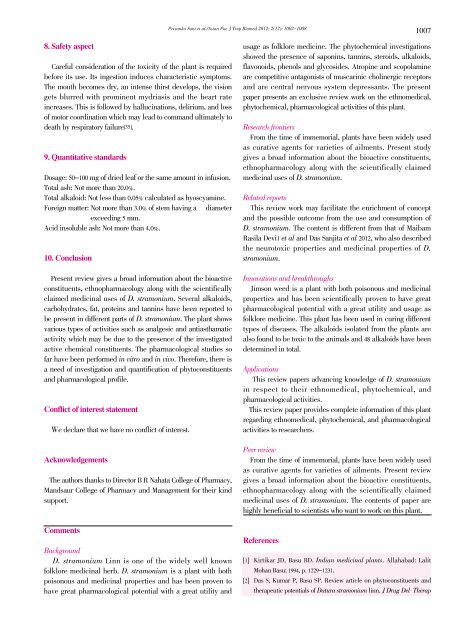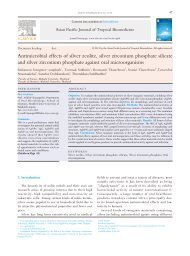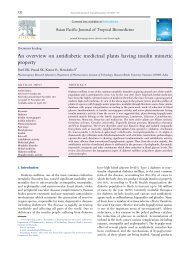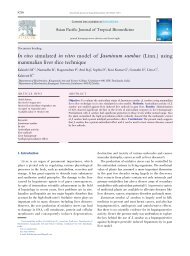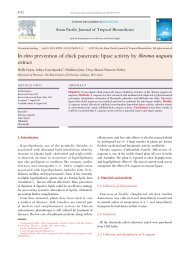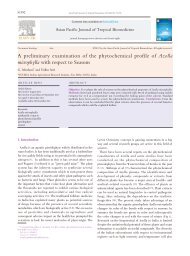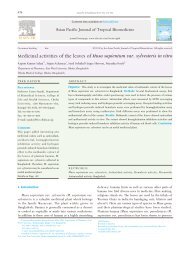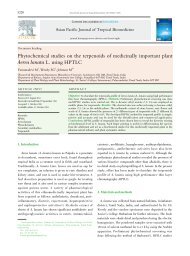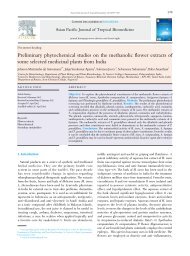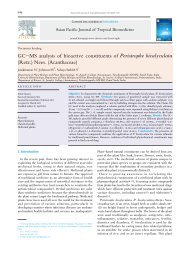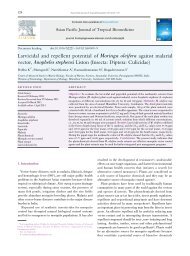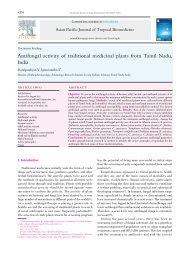Pharmacological properties of Datura stramonium L. as a - Apjtb.com
Pharmacological properties of Datura stramonium L. as a - Apjtb.com
Pharmacological properties of Datura stramonium L. as a - Apjtb.com
Create successful ePaper yourself
Turn your PDF publications into a flip-book with our unique Google optimized e-Paper software.
8. Safety <strong>as</strong>pect<br />
Careful consideration <strong>of</strong> the toxicity <strong>of</strong> the plant is required<br />
before its use. Its ingestion induces characteristic symptoms.<br />
The mouth be<strong>com</strong>es dry, an intense thirst develops, the vision<br />
gets blurred with prominent mydri<strong>as</strong>is and the heart rate<br />
incre<strong>as</strong>es. This is followed by hallucinations, delirium, and loss<br />
<strong>of</strong> motor coordination which may lead to <strong>com</strong>mand ultimately to<br />
death by respiratory failure[35].<br />
9. Quantitative standards<br />
Dosage: 50-100 mg <strong>of</strong> dried leaf or the same amount in infusion.<br />
Total <strong>as</strong>h: Not more than 20.0%.<br />
Total alkaloid: Not less than 0.05% calculated <strong>as</strong> hyoscyamine.<br />
Foreign matter: Not more than 3.0% <strong>of</strong> stem having a diameter<br />
exceeding 5 mm.<br />
Acid insoluble <strong>as</strong>h: Not more than 4.0%.<br />
10. Conclusion<br />
Present review gives a broad information about the bioactive<br />
constituents, ethnopharmacology along with the scientifically<br />
claimed medicinal uses <strong>of</strong> D. <strong>stramonium</strong>. Several alkaloids,<br />
carbohydrates, fat, proteins and tannins have been reported to<br />
be present in different parts <strong>of</strong> D. <strong>stramonium</strong>. The plant shows<br />
various types <strong>of</strong> activities such <strong>as</strong> analgesic and anti<strong>as</strong>thamatic<br />
activity which may be due to the presence <strong>of</strong> the investigated<br />
active chemical constituents. The pharmacological studies so<br />
far have been performed in vitro and in vivo. Therefore, there is<br />
a need <strong>of</strong> investigation and quantification <strong>of</strong> phytoconstituents<br />
and pharmacological pr<strong>of</strong>ile.<br />
Conflict <strong>of</strong> interest statement<br />
We declare that we have no conflict <strong>of</strong> interest.<br />
Acknowledgements<br />
The authors thanks to Director B R Nahata College <strong>of</strong> Pharmacy,<br />
Mandsaur College <strong>of</strong> Pharmacy and Management for their kind<br />
support.<br />
Comments<br />
Background<br />
D. <strong>stramonium</strong> Linn is one <strong>of</strong> the widely well known<br />
folklore medicinal herb. D. <strong>stramonium</strong> is a plant with both<br />
poisonous and medicinal <strong>properties</strong> and h<strong>as</strong> been proven to<br />
have great pharmacological potential with a great utility and<br />
Priyanka Soni et al./Asian Pac J Trop Biomed 2012; 2(12): 1002-1008 1007<br />
usage <strong>as</strong> folklore medicine. The phytochemical investigations<br />
showed the presence <strong>of</strong> saponins, tannins, steroids, alkaloids,<br />
flavonoids, phenols and glycosides. Atropine and scopolamine<br />
are <strong>com</strong>petitive antagonists <strong>of</strong> muscarinic cholinergic receptors<br />
and are central nervous system depressants. The present<br />
paper presents an exclusive review work on the ethnomedical,<br />
phytochemical, pharmacological activities <strong>of</strong> this plant.<br />
Research frontiers<br />
From the time <strong>of</strong> immemorial, plants have been widely used<br />
<strong>as</strong> curative agents for varieties <strong>of</strong> ailments. Present study<br />
gives a broad information about the bioactive constituents,<br />
ethnopharmacology along with the scientifically claimed<br />
medicinal uses <strong>of</strong> D. <strong>stramonium</strong>.<br />
Related reports<br />
This review work may facilitate the enrichment <strong>of</strong> concept<br />
and the possible out<strong>com</strong>e from the use and consumption <strong>of</strong><br />
D. <strong>stramonium</strong>. The content is different from that <strong>of</strong> Maibam<br />
R<strong>as</strong>ila Devi1 et al and D<strong>as</strong> Sanjita et al 2012, who also described<br />
the neurotoxic <strong>properties</strong> and medicinal <strong>properties</strong> <strong>of</strong> D.<br />
<strong>stramonium</strong>.<br />
Innovations and breakthroughs<br />
Jimson weed is a plant with both poisonous and medicinal<br />
<strong>properties</strong> and h<strong>as</strong> been scientifically proven to have great<br />
pharmacological potential with a great utility and usage <strong>as</strong><br />
folklore medicine. This plant h<strong>as</strong> been used in curing different<br />
types <strong>of</strong> dise<strong>as</strong>es. The alkaloids isolated from the plants are<br />
also found to be toxic to the animals and 48 alkaloids have been<br />
determined in total.<br />
Applications<br />
This review papers advancing knowledge <strong>of</strong> D. <strong>stramonium</strong><br />
in respect to their ethnomedical, phytochemical, and<br />
pharmacological activities.<br />
This review paper provides <strong>com</strong>plete information <strong>of</strong> this plant<br />
regarding ethnomedical, phytochemical, and pharmacological<br />
activities to researchers.<br />
Peer review<br />
From the time <strong>of</strong> immemorial, plants have been widely used<br />
<strong>as</strong> curative agents for varieties <strong>of</strong> ailments. Present review<br />
gives a broad information about the bioactive constituents,<br />
ethnopharmacology along with the scientifically claimed<br />
medicinal uses <strong>of</strong> D. <strong>stramonium</strong>. The contents <strong>of</strong> paper are<br />
highly beneficial to scientists who want to work on this plant.<br />
References<br />
[1] Kirtikar JD, B<strong>as</strong>u BD. Indian medicinal plants. Allahabad: Lalit<br />
Mohan B<strong>as</strong>u; 1994, p. 1229-1231.<br />
[2] D<strong>as</strong> S, Kumar P, B<strong>as</strong>u SP. Review article on phytoconstituents and<br />
therapeutic potentials <strong>of</strong> <strong>Datura</strong> <strong>stramonium</strong> linn. J Drug Del Therap


